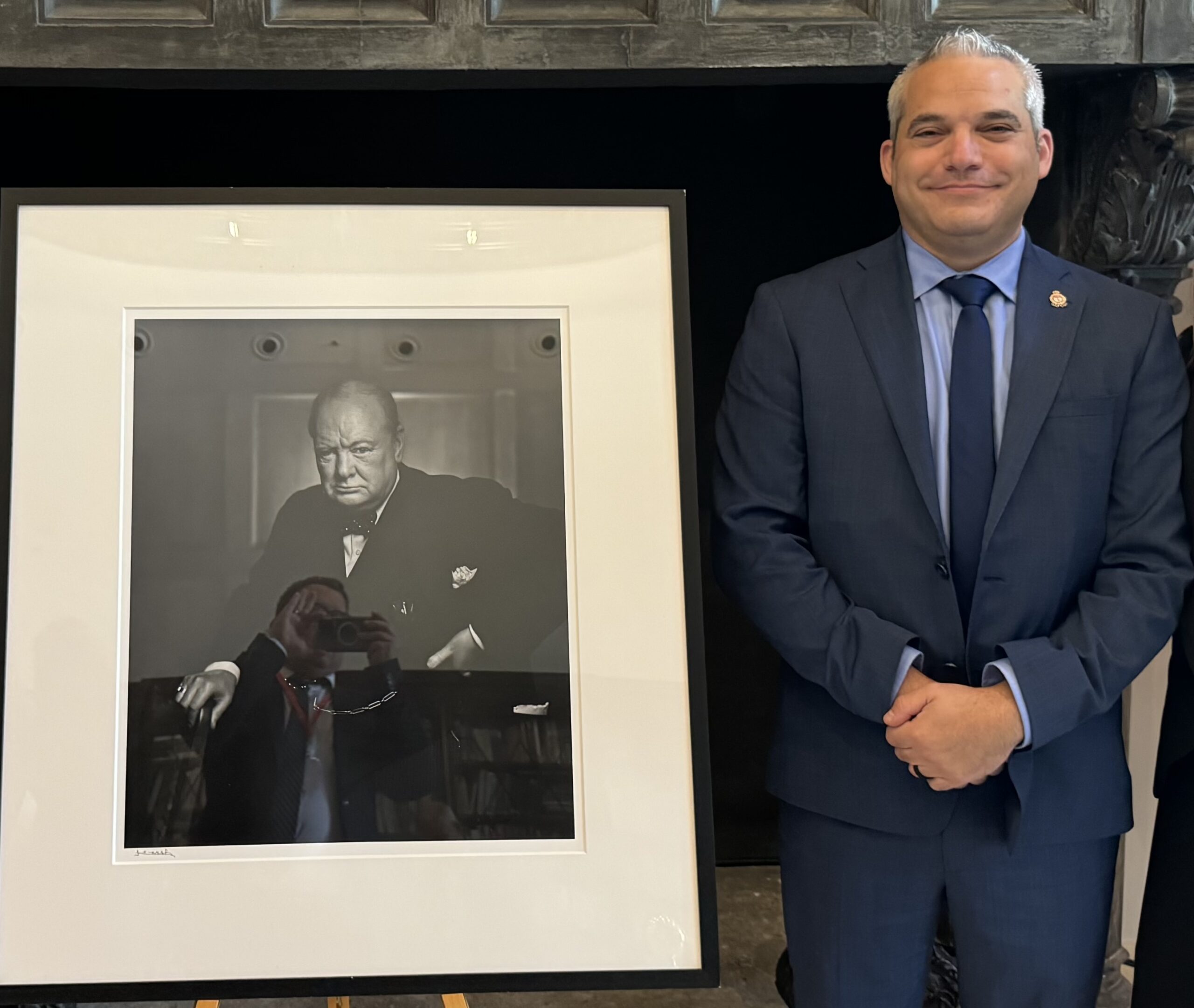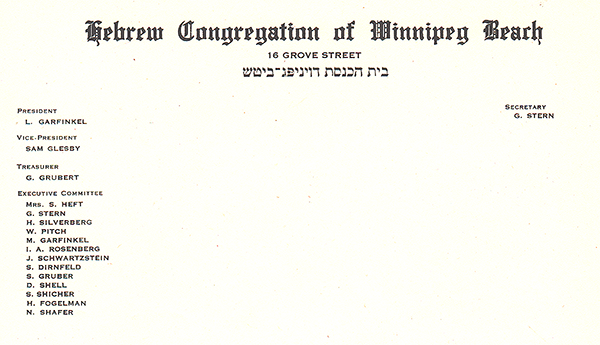Features
Ottawa police detective Akiva Geller and the case of the famed purloined Yousef Karsh photograph

By MYRON LOVE It had all the elements of a novel, heist movie or televison episode – a brazen art thief and forger, an iconic work of art, secret storage lockers, DNA and an international trail of crumbs to follow ..and Ottawa police service detective (also a former Winnipegger) Akiva Geller was right in the middle of the action.
The case revolved around the theft from the Fairmont Chateau Laurier Hotel of an iconic photograph of Winston Churchill, taken in 1941, \by the world famous photographer Yousef Karsh. Karsh and his wife, Estrellita, lived at the classy hotel for 18 years. Toward the end of his life, the photographer donated that print – “The Roaring Lion” – along with several others to the hotel. The print, valued at $20,000, was hung in the hotel’s reading room. It was reported stolen – and replaced with a forgery – in the summer of 2022.
Geller joined the Ottawa police force in 2012 following a 14-year career in the Canadian military.
He recalls that he initially considered becoming a pharmacist. He was inspired to change his plans by the yeoman work of the Canadian soldiers who helped stem the tide during the great flood here in 1997.
“That kind of community service resonated with me,’ he says. “I appreciated the hands-on aspect of it all.”
He enlisted the next year.
While serving in the military largely in a series of administrative and teaching capacities, Geller began taking classes at Algonquin College in security management that led to his taking a criminology program – and degree – at Carleton University.
He left the military in 2012 to join the Ottawa police force. He began his policing career as a patrol officer. He was promoted to the investigative branch in 2020.
Now, unlike what we may see on television, being a police detective is not a case of investigating the murder of the week. Geller notes that much of his time is spent looking into suspicious deaths – including overdoses. A high profile case such as the Karsh photo heist comes along once in a lifetime for most police detectives.
This articular story begins, according to Geller, somewhere between late December 2021, and mid-January 2023, when an individual who has since been identified as Jeffrey Wood,walked into the hotel, removed the framed portrait print from the wall, and replaced it with a copy on which Wood had forged Karsh’s signature. At the time, the hotel was largely shut down due to the Covid lockdowns; thus few people were around.
The switch wasn’t discovered, Geller reports, until the following August, when hotel engineer Bruno Lair noticed that the framed print was a little off kilter. When he went to straighten it, he saw that the portrait was hung by a wire – with holes in the wall where screws had held the portrait in place.
“Wood was identified as the seller after we obtained the response to a ‘Mutual Legal Assistance Request’ sent o the United Kingdom,” Geller recalls. “In the response, Sotheby’s London gave us his information, including scanned copies of his passport and IDs.”
The Hotel GM and staff contacted the Yousuf Karsh estate and spoke to the director, Jerry Fielder, who, it was assumed, could verify whether the fraudulent portrait signature was forged, Geller continues. He was sent a picture of the signature and fake portrait, confirmed it was forged and that the portrait was a fake. The hotel reported the theft of the authentic Roaring Lion to Ottawa Police, at which time
Geller began his investigation. Geller goes on to say: “In searching for the authentic portrait I sourced two photos of the authentic portrait on the wall before it was stolen, one from Trip Advisor and the other from Twitter. Both had the portrait signature clearly visible so I could compare them to other signatures I found.
“I came across the Sotheby’s London Auction from May 2022 in which a portrait with a very similar size and signature was sold,” Geller says. “I compared the signature to the ones I sourced from online and determined they were the same. I asked Library and Archives Canada to assist in examining the fake print and also in comparing the signatures. While signature analysis is not in their expertise, they were able to advise that it was highly probable that they were the same. With this I was able to complete a Mutual Legal Assistance Request to the United Kingdom for assistance in obtaining the details of the Sotheby’s Auction. London Metropolitan Police assisted in obtaining the information on the auction and sent it back to me here in Canada. This took almost a year to obtain because of the levels of approvals, editing and paperwork involved.”
Sotheby’s London’s documents identified the seller of the Roaring Lion portrait as well as details about him, communications they had with him and photographs of the portrait before it was obtained by Sotheby’s. Wood was identified as the seller.
“I wrote numerous production orders to all of Wood’s known bank accounts, phone numbers, and credit cards,” Geller recalls. “Once I received the return from his phone company I had to go line by line through his phone bills. There I found a phone call to a storage unit here in Ottawa.”
I wrote a search warrant for the storage locker and a production order for the information on the locker and owner. I executed the search warrant and, in the locker, we found a second fake Churchill print,” he reports. “We also found a toothbrush which we believed would have Wood’s DNA on it. We sent the toothbrush directly to the Centre for Forensic Sciences in Ontario. They compared the DNA from the toothbrush to DNA obtained from inside the fake portrait which was put up in the real one’s place.”
The next piece of the puzzle was to reclaim the portrait to return it to the Chateau Laurier. The drawback here that the buyer of the portrait was an Italian lawyer – one Nicola Castinelli. In Italy, Geller notes, if you buy stolen items in good faith – in other words, if you didn’t know the item was stolen – you have a legal claim to the property, which would mean that you would have to be taken to court to have you relinquish it.
Geller reports that the Italian carabinieri in Rome sent officers to visit the buyer in Genoa and persuaded him to return the portrait in return for what he paid.
Wood was arrested last April. At his hearing on March 14, he pleaded guilty.
Geller reports that, although the maximum sentence is 14 years in prison, the prosecution is requesting of the court a two year sentence while his lawyer is asking for a suspended sentence.
As for the portrait, it was reframed and remounted at the chateau Laurier in the former reading room, which has been converted into a lounge. He adds that the hotel now has a lot more security in place.
“It was a nice reinstallation ceremony,” Geller says.
Mrs. Karsh (who is in her 90s) even wrote a letter to the hotel expressing her appreciation about the portrait being “back home”, he adds.
Features
Winnipeg Beach Synagogue about to celebrate 75th anniversary

By BERNIE BELLAN (July 13) In 1950 a group of cottage owners at Winnipeg Beach took it upon themselves to relocate a one-room schoolhouse that was in the Beausejour area to Winnipeg Beach where it became the beach synagogue at the corner of Hazel and Grove.
There it stayed until 1998 when it was moved to its current location at Camp Massad.
On August 2nd members of the synagogue will be holding a 75th anniversary celebration.

As part of the celebration anyone who is a descendant or relative of any of the original members of the first executive committee (as seen in the photo here) is invited to attend the synagogue that morning.
If you are a relative please contact Abe Borzykowski at wpgbeachshule@shaw.ca or aborzykowski@shaw.ca to let Abe know you might be attending or for more information about the 75th anniversary celebration.
We will soon be publishing a story about the history of the beach synagogue, which is something I’ve been writing about for over 25 years.
Features
Kinzey Posen: CBC Winnipeg’s former “go-to guy”

By GERRY POSNER If former Winnipegger Lawrence Wall was the CBC go-to guy in Ottawa, CBC Winnipeg had its own version of a go-to guy for many years with none other than the very well known Kinzey Posen. Of course, many readers will recognize that name from his career with Finjan, the Klezmer group so famous across Canada and beyond. It has been written about Posen and his wife Shayla Fink that they have been involved in music since they got out of diapers. And, as an aside, their love and ability in music has now been transmitted to the next generation as in their son, Ariel Posen (but that’s another story).
Kinzey Posen (not to be confused with Posner, or maybe we are to be confused, but who knows for sure?), was a graduate of Peretz School, having attended there from nursery right until Grade 7, graduating in1966. That was followed by Edmund Partridge and West Kildonan Collegiate. Musically, he was in large part self taught. However, he did have some teachers along the way. After moving to Vancouver – from 1974-78, he had the chance to study acoustic classical bass with a member of the Vancouver Symphony Orchestra. When Kinzey lived in Vancouver, he also worked as a jazz musician.
Upon returning to Winnipeg, Kinzey enrolled as a mature student at the University of Winnipeg, where he obtained a Bachelor of Urban Studies degree. Although the degree was in no way connected to the career that followed, his attending the University of Winnipeg was critical to his connecting with the CBC. Why? you ask. Kinzey had a position after graduation working for the Institute of Urban Studies. While there, he met someone who invited him to work for the Department of Continuing Education as one of their program directors. At the time the Department of Continuing Education was located at 491 Portage Avenue, which was also known as the TJ Rice Building. The CBC also leased some space in the same building. According to Kinzey, the CBC part of the building “included HR, different shows and other support offices. Continuing Education was located in the basement and main floor and that’s where I worked.”
KInzey had long had an interest in the CBC, which made the fact that the CBC had some offices in the same building where he was working serendipitous. That Kinzey might be interested in visiting the CBC was not an accident. As a young boy he had a nightly connection to CBC, as it was his ritual to listen to CBC Radio (as well as all sorts of other radio stations across the USA) on his transistor radio every night in bed. He became enamoured of one particular CBC host, Bill Guest, so that when going to sleep, he imagined that he was Guest doing interviews with imaginary guests. That dream of working for CBC became a reality when he had a chance to do a one week gig with Jack Farr’s network program.
Kinzey took a week off from his Continuing Education job and spent five days at the CBC. That week was a training session for Posen, as he had to create ideas, research, pre-interview, write the script, and set up the studio for Farr’s interview. He was almost in his dream job – although not quite – since it was only for one week. His opportunity, however, came in 1988, when he was offered a one-year term as a production assistant – the lowest guy on the ladder, for a show called “ Simply Folk,” with the late Mitch Podolak as the host. Although he was indeed at the bottom as far as those working on the show were concerned, he took a chance and gave his notice to the U of W. The rest is history. In his new job, Kinzey learned how to become a producer. Lucky for him, at the end of the year, when the person he replaced was supposed to come back, she never returned (just like the song, “MTA,” by the Kingston Trio). At that point, Kinzey was hired full time at the CBC.
Kinzey was a fixture at the CBC for 27 years. During those years, Kinzey had the chance to work with Ross Porter, a respected former CBC host and producer, also with Karen Sanders – on the “Afternoon Edition.” One aspect of Kinzey’s job on the Afternoon Edition was to come up with ideas, mix sound effects, arrange interviews and music, to create a two-hour radio experience. In addition, he covered jazz and folk festivals and, as a result, was exposed to some of the best musicians in the world. With Ross Porter in the 1990s, he worked on a network jazz show called “ After Hours,” which was on from 8-10 PM five nights a week. Kinzey was involved with writing the scripts, picking the music, and recording the shows, as well as editing them and then presenting them to the network for playback.
Of course, over his career, Kinzey had many memorable moments. He told me about one of them. The story revolved around the National Jazz Awards one year in particular. The awards were to be broadcasted after the National News which, in those days, began much earlier in the evening, and were over by 8:00 pm. The legendary Oscar Peterson was lined up to play a half hour set at the awards, starting at 7:30. But, as Kinzey told me, Oscar Peterson had a “hate on” for the CBC ecause one of his recorded performances was wrongly edited and he refused to appear on CBC under any circumstances. As the time neared 8:05 PM, which was when the CBC was to begin its broadcast of the jazz awards, it became apparent that Oscar was not going to finish on time. As the producer of the awards show, Kinzey was tasked with telling Oscar Peterson to wrap it up and get off the stage. There was Kinzey Posen, a huge fan of Oscar Peterson, now faced with the prospect of telling Oscar – while he was still playing – with 500 people in the audience, to stop and get off the stage. Not often was or is Kinzey Posen frozen, but that was one such moment. There was one loud “Baruch Hashem” from Kinzey when Oscar completed his set literally just in time.
Clearly, Kinzey was part of a very successful run with After Hours as it was on the air for 14 years. It was easily one of the most popular shows on CBC Radio 2, and a winner of several broadcasting awards. Kinzey also played a major role in producing a two part documentary about legendary guitarist Lenny Breau.
When After Hours ended, Posen became one of the contributing producers to Canada Live and specialized in producing live radio specials for the network, such as the Junos, for CBC Radio One and Two. Needless to say, his career planted Posen in the world of some top notch musicians, including his time spent working with Robert Plant (Led Zeppelin), Dave Brubeck, Randy Bachman, Chantal Kreviazuk and a list of prominent names in the Canadian, American and European music spheres. Locally, the CBC came to refer to Kinzey as the Jewish expert. I would add music expert to that title.
After his 27 year run at the CBC – and before he fully retired, Kinzey went on to work for the Rady JCC as a program director for a year and a half. Of course, to say that Kinzey Posen is retired is a major contradiction in terms. You really can’t keep him down and he has his hand in a variety of programs and projects – most of which he remains silent about, as is his style.
When I realized the full depth and talent of Kinzey Posen, I quickly concluded that he must certainly be related to me. Even if he isn’t, I now tell people he is.
Features
History of a Holocaust Survivor Turning Eighty

By HENRY SREBRNIK On July 19, I turn 80 years old. This is indeed a milestone, but for me, an even bigger one was just being born. My parents were Holocaust survivors, and I found out just a few months ago that, technically, so am I. My parents were from Czestochowa, Poland, where I was born in 1945. By 1943 most Jews in the city, including their own families, had been murdered by the Nazis, at Treblinka, and after the uprising in the Jewish ghetto, my parents, by now married, became slave labour in a major Nazi munitions plant, the HASAG-Pelcery concentration camp, in the city.
The Russian army liberated Czestochowa January 16-17, 1945, and I was born July 19, six months later. You can do the math. My mother was emaciated and didn’t even know she was pregnant, but another month, and it would have been obvious, and she would have been killed. (I never asked how this happened but found out when listening to her testimony for the Shoah Foundation in 1995. The men and women were housed in different barracks, but one night the Germans were delousing one of the buildings and allowed married couples to sleep together in the other.)

In 1945 the 9th of Av fell on July 19, and the Jewish world had just gone through our worst period in history. I was born in a makeshift hospital at the Jasna Gora, the famed Pauline Catholic monastery in the city. The actual city hospital had been destroyed in the fighting. It is home to the Matka Boska Czestochowska, (“the mother of God”), a very beautiful and large icon of Mary and the baby Jesus. Other women giving birth were surprised and one said, “Ona jest Zydowka” (She’s a Jew). So, though I am a proud Polish Jew, this could only have helped! The doctor who delivered whispered to my mother that he was Jewish but added that he wanted it kept quiet because he wasn’t going to leave Poland. It also took awhile for a mohel to come to the city for me.
The next few years were spent in Pocking-Waldstadt, a DP camp in the American zone in Bavaria, Germany, and then on to Pier 21 in Halifax and Canada. We lived in Montreal, though at home we were to all intents and purposes in Czestochowa, Jewish Poland.
As I was packing up my books in May because we all had to vacate our offices for the summer due to repairs in our building, I came across a book that I had never read – I don’t even recall where I got it — by the Polish historian Lucjan Dobroszycki, Survivors of the Holocaust in Poland: A Portrait Based on Jewish Community Records 1944-1947 (Armonk, New York: M.E. Sharpe, 1994). Chapter 5 is comprised of “Lists of Jewish Children Who Survived,” in alphabetical order. I am listed on p. 146 (Heniek Srebrnik, 1945). I sent in a form to the Claims Conference in New York informing them. So, at age 80, I’ve become a Holocaust survivor! Compared to that start, the next decades have been easy street! As the Aussies say, “no worries! But the Jewish world has grown darker. Like many others, were I to write a memoir, I’d call it From Hitler to Hamas.
I grew up in Montreal, and have lived in Calgary and Charlottetown, as well as London, England, and four American cities. But I’ve only been to Winnipeg twice, in 1982 and, more dramatically, the weekend of Sept. 7-10, 2001. I presented a paper on “Birobidzhan on the Prairies: Two Decades of Pro-Soviet Jewish Movements in Winnipeg,” to a conference on “Jewish Radicalism in Winnipeg, 1905-1960,” organized by the Jewish Heritage Centre of Western Canada. I left the morning of Sept. 11. An hour into the flight to Toronto we were told all airplanes had to land at the nearest major airport. I spent the next three days in Sault Ste. Marie, Ont., with fellow passengers. We mostly watched the television reporting on the 9/11 catastrophe.
Though an academic, I have always written for newspapers, including Jewish ones, in Canada and the United States. Some, like the Jewish Free Press of Calgary, the Jewish Tribune of Toronto, and the previous version of the Canadian Jewish News, no longer exist, which is a shame. Fortunately, the Jewish Post still does.
Henry Srebrnik is a professor of political science at the University of Prince Edward Island.
